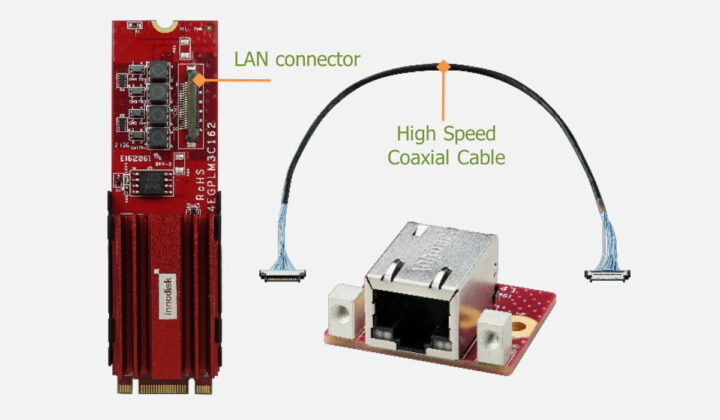It’s now possible to add 10GbE through an M.2 socket thanks to Innodisk EGPL-T101 M.2 2280 module based on Marvell AQtion Ethernet controller offering support for 10Gbps, 5Gbps, 2.5Gbps, 1000M, and 100M/10M LAN speeds.
The solution is comprised of three parts with the M.2 module equipped with a heatsink to cool the Ethernet controller, a flexible high-speed cable, and a daughter board with an RJ45 connector and two threads for mounting to a chassis.
Innodisk EGPL-T101 specifications:
- Ethernet controller – Marvell AQtion likely AQC113 “single-port 6speed, 10Gbps PCIe to Multi-Gig Ethernet controller with MAC and PHY with I-grade support”
- M.2 input interface – PCI Express 3.0 x 2
- RJ45 connector for up to 10GbE
- Power Consumption – Up to 2.5W (3.3V, 762mA)
- Dimensions (W x L x H/mm)
- M.2 Board: 22 x 80 x 14.5 mm (M.2 2280 form factor)
- Daughter Board: 31.75 x 28 x 17.7 mm
- Temperature Range – Operation: 0°C ~ +55°C; Storage: -55°C ~ +95°C
- Vibration – 5G @7~2000Hz
- Shock – 50G @ 0.5ms
- Complies with EN61000-4-2 (ESD) Air-15kV, Contact-8kV
Innodisk provides drivers for Windows 10 or greater, and Linux distributions with kernel 3.10 or later. The company warns LRO (Large Receive Offload) is enabled by default in the drivers to achieves the lowest CPU utilization, but it should be disabled if the user needs ip forwarding or bridging,
Innodisk says the EGPL-T101 is the first M.2 2280-to-single 10GbE Base-T Ethernet module, and also happens to be the world’s smallest 10GbE expansion solution so far. Applications that may make use of the module include machine vision in industrial applications, high throughput network data transmission, high-resolution imaging for surveillance, and casino gaming machines.
Mass production of the EGPL-T101 M.2 to 10GbE module is said to have started in December 2021, and it’s already available in some shops for $166, although we are told to contact the distributor for “availability and current pricing”. More details, including Windows and Linux drivers, can be found on the product page.

Jean-Luc started CNX Software in 2010 as a part-time endeavor, before quitting his job as a software engineering manager, and starting to write daily news, and reviews full time later in 2011.
Support CNX Software! Donate via cryptocurrencies, become a Patron on Patreon, or purchase goods on Amazon or Aliexpress





